 Considering the shortcomings and demerits of the current electoral systems we are proposing negative voting as a method of elections.
Considering the shortcomings and demerits of the current electoral systems we are proposing negative voting as a method of elections.(Written by Arvind Patil and Sundeep Bedi)
Before we embark on the journey to redesign our electoral system and redefine democracy, let’s refer to the Madras High Court judgment. The Madras HC has ordered that the negative marking system should be abolished from competitive exams. Justice R Mahadevan remarked that the system would discourage students. The order was delivered on a petition filed in 2013 by a student who couldn’t qualify for the IIT-JEE. This order relates to the prevalent practice of negative marking in a system of student evaluation synonymous with selection to the IITs, IIMs, NITIE and medical colleges.
For those who are uninitiated on the ways and means of getting into prestigious colleges and universities or landing oneself an administrative services job through UPSC examinations, negative marking refers to that practice of exam assessment wherein the student or a candidate is rewarded with a positive mark for a correct answer and a negative mark for a wrong answer. The final result or score obtained by a candidate is computed by the net result of all the pluses and minuses. For example, in a 100 marks MCQ paper, if a candidate aspirant or applicant answers 75 questions correctly then she/he will be awarded 75 marks and suppose the said student/candidate has answered 20 questions wrongly and avoided five questions then the final result tally will read like this — marks obtained: 55 (75-20 = 55).
Let us proceed to tackle the theme of electoral reforms. The worldwide practice of elections is focused on two principal systems. The Proportional Representation (PR) system characterises electoral systems in which divisions in an electorate are reflected proportionately in the elected body. If n per cent of the electorate support a particular political party or set of candidates as their favourite, then roughly n per cent of seats will be won by that party or those candidates. The essence of such systems is that all votes contribute to the result — not just a plurality, or a bare majority. The most prevalent forms of proportional representation require the use of multiple-member voting districts (also called super-districts), as it is not possible to fill a single seat in a proportional manner. PR systems that achieve the highest levels of proportionality tend to include districts with large numbers of seats.
The most widely used varieties of PR electoral systems are party-list PR, the single transferable vote (STV), and mixed-member proportional representation (MMP).
In the first-past-the-post electoral system, voters cast their vote for a candidate of their choice, and the candidate who receives the most votes wins. FPTP is a plurality voting method and is primarily used in systems that use single-member electoral divisions. FPTP is used in about one-third of the world’s countries, mostly in the English-speaking world.
Considering the shortcomings and demerits of the current electoral systems we are proposing negative voting as a method of elections. What we are suggesting is a revolutionary shift in the way in which elections are organised. In this method of elections, a candidate will be elected based on the net number of votes cast in her/his favour. Voters will be expected to cast plus — positive — votes and/or minus (negative) votes.EVMs will compute the final result by calculating all the positive and negative votes cast in a candidate’s vote count. Hypothetically, it may be possible that a candidate with zero votes or the least negative votes might get elected to Parliament. State assemblies, legislative councils, municipal corporations and councils, zila parishads and gram panchayats could also subscribe to this election methodology. One basic merit of such a system would be that candidates will have to work towards addressing the needs and concerns of all sections of society, instead of the polarisation-based strategy currently being adopted.
The malpractices that are presently in vogue during elections shall become ineffective and the barriers for new entrants will be significantly lowered. If this system is implemented, we are likely to get better quality lawmakers and improved policy making resulting in superior governance.
Patil is a political analyst, lawyer and technologist. Bedi is an economist.